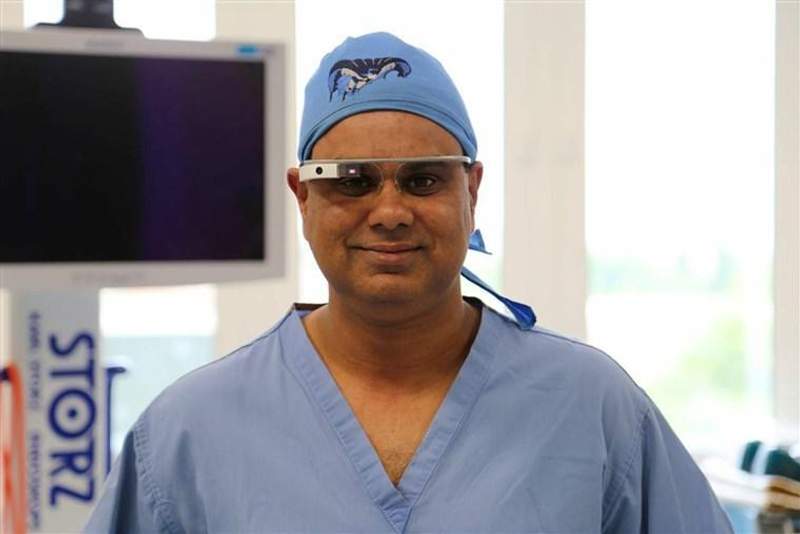Diane Jooris is pioneering research into VR for patients (Oncomfort)
Two medical specialists talk about how they are using VR for both doctors and patients in surgery.
Virtual reality was first introduced in video gaming as an odd and futuristic concept that many people did not expect to break out of the gaming world.
But as research into the technology has evolved, VR has found itself an unlikely home in healthcare, where it is being pioneered by practitioners in different areas of medicine including mental health studies, pain management and surgery.
Research that into VR that is currently being carried out is focused on helping both patients and doctors. Dr Shafi Ahmed, a colorectal surgeon at St Bartholomew’s, has been using VR to live-stream surgical procedures around the world with the aim of teaching surgeons how to perform different procedures. Dr Diane Jooris, a psychologist based in Belgium, is using the technology to change the way patients experience pain and anxiety when they undergo surgical procedures.
In 2016, Dr Ahmed live-streamed an operation on a patient with colon cancer in virtual reality usirng 360-degree perspective, so that people around the world could ‘tune in’ using VR technology and learn how the procedure was performed.
“I am using these kinds of technologies to train people and educate people en masse,” Dr Ahmed says.
“It’s connecting people around the world. We’re not teaching one or two people but thousands.”
When Dr Ahmed broadcasts a surgical training session in VR, he can bring people into the operating theatre with their VR headsets and see them as computerised avatars in the room. He has been able to broadcast to more than 100 countries and he believes it is the solution to teaching surgeons across the world in great numbers, which could address the global shortage of specialist surgeons.
“Live training and simulation will be much better than how things were done before,” he argues.
Describing the next generation of doctors as “digital natives” who have grown up around technology, he thinks VR marks a “natural continuum” in how people are taught.
“We’ve come a long way from papyrus, paper and print, and now online platforms.”
Although he was initially unsure about how VR would be used in medicine in the long-term, Dr Ahmed now believes it is “here to stay” after seeing promising results in its use in mental health.
And those results have come from studies conducted by Diane Jooris, who is using VR to help patients before, during and after invasive procedures.
While working at MD Anderson Cancer Centre in Houston, Texas, Jooris specialised in clinical hypnosis, with a focus on teaching patients to enter a different state of consciousness which changes the way they perceive pain and reduces their anxiety levels. Jooris claims that when a patient has reached a state of hypnosis, they do not need to be sedated when they go under the knife.
“You still have to have local anaesthetic. It’s not a miracle,” Jooris says.
Perhaps it is not quite magic, but it is an impressive technique. Patients who have undergone hypnosis before surgery and remained conscious throughout the procedure have said they can feel the tools at work, but do not report any pain.
Now, Jooris has brought VR into her work and is heading up a company in Belgium called OnComfort, which uses a VR device rather than a hypnosis specialist to put the patient into the hypnotic state.
Firstly, the patient about to undergo surgery puts on the VR device. They will see a different background (which is modified depending on the patient’s needs) while a voice speaks to them to help them fall into a different state of consciousness. At the moment, the VR programs come in seven different languages.
So far, Jooris has used the technology on more than 1500 patients ranging from two and a half years old to older than 100. Surprisingly, she says, the elderly patients are the most keen to give the technology a try.
“Geriatric patients just jump into the experience.”
Preliminary results from patients who have had breast cancer surgery show that using the technology can reduce post-op anxiety by 56 per cent, and bring down post-op pain by 45 per cent.
On top of this, the time patients spend recovering in hospital after an operation goes down by 35 per cent.
OnComfort’s findings have been used by pro-VR doctors to make the case for the technology in medicine. Dr Ahmed says Jooris’s research, along with other projects researching VR, have made him sure it will change the way the healthcare industry operates.
“VR is here to stay. A year ago, I wasn’t so sure,” he admits.
As the world’s population continues to grow, the demand for healthcare grows with it. Where VR is being trialled, it is to help cope with that demand by helping doctors, and should not be feared, according to Jooris and Dr Ahmed.
Dr Ahmed argues that, as long as technology is monitored by humans, its use in healthcare should be embraced.
“This is the most exciting time to be alive in medicine.
“But doctors should remain at the forefront of the interface to be sure we do our best to mitigate risk and maintain dignity and trust.”
His message to patients is not to be scared but to accept that technology, including virtual reality, is going to change the way healthcare is provided in future.

